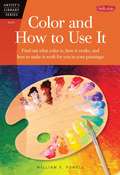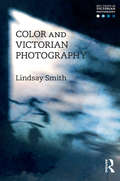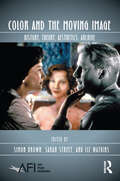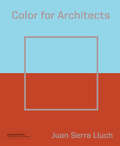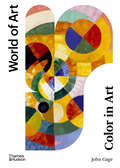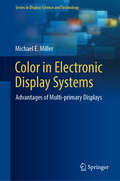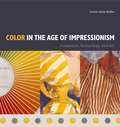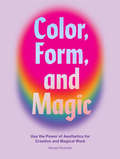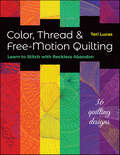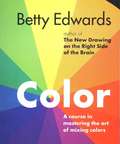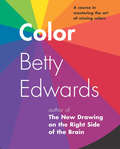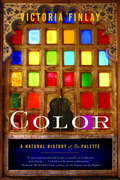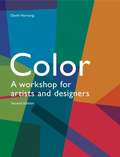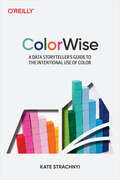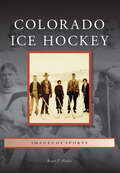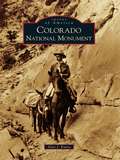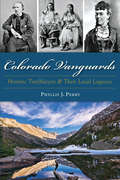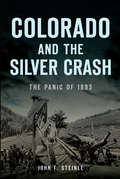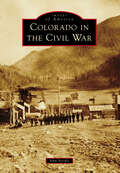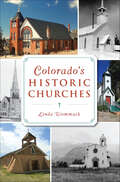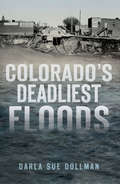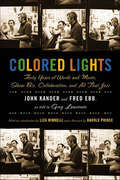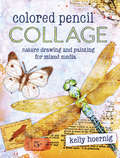- Table View
- List View
Color and How to Use It
by William F. PowellFrom the most delicate pastel tint to the boldest bright hue, color is a vitally important tool to you as an artist. Whether your preferred medium is acrylic, oil, or watercolor, a strong understanding of color and its applications is essential. Color and How to Use It includes in-depth information on color theory, important properties of color and light, and the fundamentals of color mixing. This comprehensive guide will teach you what color is, how it works, and how to make it work for you in your paintings.
Color and Victorian Photography (Key Texts in Victorian Photography)
by Lindsay SmithNineteenth-century photography is usually thought of in terms of ‘black and white’ images, but intense experimentation with generating and fixing colors pre-dated the public announcement of the daguerreotype in 1839. Introducing readers to the long, frequently overlooked story of the relationship of color to photography, this short anthology of primary sources includes: accounts of the scientific search for color by Elizabeth Fulhame and Sir John Herschel;photographers' views on color; extracts from the photographic press and from manuals on handcoloring; and accounts by critics such as John Ruskin. The volume provides a fresh perspective on the culture, history and theory of early photography, demonstrating why scientists, philosophers, photographers, literary writers and artists were so fascinated by the potential for polychrome in photographs. With an introductory essay arguing that from the earliest days of photography the prospect of color loomed large in the imagination of its creators, users and critics, this reader is an essential resource for students and scholars wanting to gain a full understanding of nineteenth-century photography and its relationship to art history, literature and culture.
Color and the Moving Image: History, Theory, Aesthetics, Archive (AFI Film Readers)
by Simon Brown Sarah Street Liz WatkinsThis new AFI Film Reader is the first comprehensive collection of original essays on the use of color in film. Contributors from diverse film studies backgrounds consider the importance of color throughout the history of the medium, assessing not only the theoretical implications of color on the screen, but also the ways in which developments in cinematographic technologies transformed the aesthetics of color and the nature of film archiving and restoration. Color and the Moving Image includes new writing on key directors whose work is already associated with color—such as Hitchcock, Jarman and Sirk—as well as others whose use of color has not yet been explored in such detail—including Eric Rohmer and the Coen Brothers. This volume is an excellent resource for a variety of film studies courses and the global film archiving community at large.
Color for Architects (Architecture Brief)
by Juan Serra LluchAs far back as the earliest Greek temples, color has been an integral part of architecture but also one of its least understood elements. Color theory is rarely taught in architecture schools, leaving architects to puzzle out the hows and whys of which colors to select and how they interact, complement, or clash. Color for Architects is profusely illustrated and provides a clear, concise primer on color for designers of every kind. This latest volume in our Architecture Briefs series combines the theoretical and practical, providing the basics on which to build a fuller mastery of this essential component of design. A wealth of built examples, exercises, and activities allows students to apply their learning of color to real-world situations.
Color in Art (World of Art #0)
by John GageA wide-ranging and engaging introduction to the place and power of color in life and art by John Gage, author of the award-winning Color and Culture. The complex phenomenon of color has received detailed attention from the perspectives of physics, chemistry, physiology, psychology, linguistics, and philosophy. However, the people who work most closely with color—artists—have rarely been canvassed for their opinions on this mysterious subject. John Gage sets out to address this omission by focusing on the thoughts and practices of artists. Color in Art is concerned with the history of color, but is not itself a history; instead each chapter develops a theme from a different scientific discipline, as seen from the viewpoint of such diverse artists such as Vincent van Gogh, Wassily Kandinsky, Sonia Delaunay, Bridget Riley, and Clifford Possum Tjapaltjarri. Drawing on examples through the ages, from ancient times to the present, the many topics covered include flags, synesthesia, theosophy, theater design, film, chromotherapy, and chromophobia. Featuring a new foreword by art writer Kelly Grovier outlining contemporary developments in the study of color and an updated bibliography, this new edition of this classic text offers a wide-ranging and engaging introduction to the place and power of color in life and art.
Color in Electronic Display Systems
by Michael E. MillerThis book explores the principles, design, and image processing of multi-primary displays, and introduces the reader to the intricacies of the typical imaging pathways which influence display design and the perception of color within a display system. Early chapters introduce the concepts behind human perception, color science, and lighting, which are necessary to fully understand multi-primary displays. The reader is also introduced to digital capture and transmission systems to better understand the ecosystem in which multi-primary displays exist. Subsequent chapters introduce the reader to current display technologies, including LCD, OLED, and inorganic LED displays. The working principles, performance, and upcoming advances are discussed for each of these technologies to provide the reader with a clear understanding of the tradeoffs which are necessary when considering multi-primary displays. This discussion is followed by an in-depth discussion of the image processing technology necessary to implement multi-primary displays. The book concludes with chapters that clearly discuss the advantages and limitations of multi-primary displays for direct view, virtual reality, and augmented reality displays. The book provides a broad viewpoint across the entire display ecosystem, explaining the interactions among system components to provide a rationale for the further development of multi-primary displays. Whether the reader is interested in broadening their understanding of display systems or the development of multi-primary displays, the text provides and understandable and practical summary of important display system concepts.
Color in the Age of Impressionism: Commerce, Technology, and Art (Refiguring Modernism #22)
by Laura Anne KalbaThis study analyzes the impact of color-making technologies on the visual culture of nineteenth-century France, from the early commercialization of synthetic dyes to the Lumière brothers’ perfection of the autochrome color photography process. Focusing on Impressionist art, Laura Anne Kalba examines the importance of dyes produced in the second half of the nineteenth century to the vision of artists such as Edgar Degas, Pierre-Auguste Renoir, and Claude Monet.The proliferation of vibrant new colors in France during this time challenged popular understandings of realism, abstraction, and fantasy in the realms of fine art and popular culture. More than simply adding a touch of spectacle to everyday life, Kalba shows, these bright, varied colors came to define the development of a consumer culture increasingly based on the sensual appeal of color. Impressionism—emerging at a time when inexpensively produced color functioned as one of the principal means by and through which people understood modes of visual perception and signification—mirrored and mediated this change, shaping the ways in which people made sense of both modern life and modern art.Demonstrating the central importance of color history and technologies to the study of visuality, Color in the Age of Impressionism adds a dynamic new layer to our understanding of visual and material culture.
Color in the Age of Impressionism: Commerce, Technology, and Art (Refiguring Modernism)
by Laura Anne KalbaThis study analyzes the impact of color-making technologies on the visual culture of nineteenth-century France, from the early commercialization of synthetic dyes to the Lumière brothers’ perfection of the autochrome color photography process. Focusing on Impressionist art, Laura Anne Kalba examines the importance of dyes produced in the second half of the nineteenth century to the vision of artists such as Edgar Degas, Pierre-Auguste Renoir, and Claude Monet.The proliferation of vibrant new colors in France during this time challenged popular understandings of realism, abstraction, and fantasy in the realms of fine art and popular culture. More than simply adding a touch of spectacle to everyday life, Kalba shows, these bright, varied colors came to define the development of a consumer culture increasingly based on the sensual appeal of color. Impressionism—emerging at a time when inexpensively produced color functioned as one of the principal means by and through which people understood modes of visual perception and signification—mirrored and mediated this change, shaping the ways in which people made sense of both modern life and modern art.Demonstrating the central importance of color history and technologies to the study of visuality, Color in the Age of Impressionism adds a dynamic new layer to our understanding of visual and material culture.
Color, Form, and Magic: Use the Power of Aesthetics for Creative and Magical Work
by Nicole PivirottoBring the magic of color and form into your everyday life.Color and form are powerful—and not just for creative work. When used purposefully, color and shape are tools we can use to help us manifest, attract the energy we want, and become our best selves. In this accessible guide, designer and intuitive Nicole Pivirotto breaks down properties of shapes and colors, the basics of getting started with magic, and spell ideas that use color and form, like color meditation and altar building. Whether you have an existing magic practice, want to develop one, or want to use the power of color and form in your creative work, this book is an essential companion to the magic of aesthetics. With gorgeous holographic foil on the cover and book page edges, it is also a beautiful gift for any contemporary seeker with a love of bold color and design.ACCESSIBLE APPROACH TO MAGIC: This book approaches magic as a flexible and empowering practice for manifestation, healing, and self-care. And there's no need to have any special tools to get started. This book shows how visual elements we interact with every day—color, shapes, and symbols—can help you to manifest and become your best self. It's a perfect entry to magic practice for creative types and a unique guide for those looking to infuse an existing practice with more color and creativity.SPELL IDEAS: In addition to overviews of the properties of colors, a library of magical symbols, and an introduction to magic practice, this book offers spell ideas to help you achieve a desired energy or state. All the spells are simple and most are easy to perform with everyday materials. Etch a candle with a symbol and burn to release its energy around you; or, create a custom symbol personalized to your unique intention. This book encourages getting creative, and offers plenty of practical examples to illustrate how you can tailor these spells to your interests and intentions.DISPLAY-WORTHY OBJECT: With shining foil-stamped accents, vibrant illustrations and photography, and a prismatic design, this book is a stunning addition to the coffee table or nightstand, and it makes a gorgeous gift.Perfect for:• modern mystics and those looking for gifts for them• color lovers, creatives, designers, and visual thinkers with a mystic mindset
Color, Thread & Free-Motion Quilting: Learn to Stitch with Reckless Abandon
by Teri LucasUse color and thread to create the quilting of your dreams! With Color, Thread, & Free-motion Quilting, author Teri Lucas, a world-renowned master machine quilter, shares her brilliance and guidance to hone your machine quilting skills in a helpful, comprehensive, and understandable way. Quilters talk about building their fabric stashes but what about building their thread stashes, which is equally important? This book is a beautiful, well-guided and helpful resource for choosing threads––considering color, kind, and weight; choosing aids to help you quilt successfully; improving your free-motion quilting skills; and ultimately making free-motion quilting FUN! There are also lots of tips and tricks to help make your quilting enjoyable, playful, and frustration-free! Color, Thread & Free-motion Quilting is a comprehensive, go-to book that will be a staple resource in any quilter’s stash; I know it will be in mine!” ~ Pokey Bolton Thready or not! Learn how color, thread, and motif come together in machine quilting Compare actual quilted color wheels on a rainbow of various background fabrics Make your quilting a design element with solid quilting tips and color fundamentals
Color: A Course in Mastering the Art of Mixing Colors
by Betty EdwardsMillions of people have learned to draw using the methods of Dr. Betty Edwards's bestseller The New Drawing on the Right Side of the Brain. Now, much as artists progress from drawing to painting, Edwards moves from black-and-white into color. This much-awaited new guide distills the enormous existing knowledge about color theory into a practical method of working with color to produce harmonious combinations. Using techniques tested and honed in her five-day intensive color workshops, Edwards provides a basic understanding of how to see color, how to use it, and-for those involved in art, painting, or design-how to mix and combine hues. Including more than 125 color images and exercises that move from simple to challenging, this volume explains how to: see what is really there rather than what you "know" in your mind about colored objects perceive how light affects color, and how colors affect one another manipulate hue, value, and intensity of color and transform colors into their opposites balance color in still-life, landscape, figure, and portrait painting understand the psychology of color harmonize color in your surroundings While we recognize and treasure the beautiful use of color, reproducing what we see can be a challenge. Accessibly unweaving color's complexity, this must-have primer is destined to be an instant classic.
Color: A Course in Mastering the Art of Mixing Colors
by Betty EdwardsMillions of people have learned to draw using the methods of Dr. Betty Edwards's bestseller The New Drawing on the Right Side of the Brain. Now, much as artists progress from drawing to painting, Edwards moves from black-and-white into color. This much-awaited new guide distills the enormous existing knowledge about color theory into a practical method of working with color to produce harmonious combinations.Using techniques tested and honed in her five-day intensive color workshops, Edwards provides a basic understanding of how to see color, how to use it, and-for those involved in art, painting, or design-how to mix and combine hues. Including more than 125 color images and exercises that move from simple to challenging, this volume explains how to:see what is really there rather than what you "know" in your mind about colored objectsperceive how light affects color, and how colors affect one anothermanipulate hue, value, and intensity of color and transform colors into their oppositesbalance color in still-life, landscape, figure, and portrait paintingunderstand the psychology of colorharmonize color in your surroundingsWhile we recognize and treasure the beautiful use of color, reproducing what we see can be a challenge. Accessibly unweaving color's complexity, this must-have primer is destined to be an instant classic.
Color: A Natural History of the Palette
by Victoria FinlayIn this vivid and captivating journey through the colors of an artist's palette, Victoria Finlay takes us on an enthralling adventure around the world and through the ages, illuminating how the colors we choose to value have determined the history of culture itself.How did the most precious color blue travel all the way from remote lapis mines in Afghanistan to Michelangelo's brush? What is the connection between brown paint and ancient Egyptian mummies? Why did Robin Hood wear Lincoln green? In Color, Finlay explores the physical materials that color our world, such as precious minerals and insect blood, as well as the social and political meanings that color has carried through time.Roman emperors used to wear togas dyed with a purple color that was made from an odorous Lebanese shellfish-which probably meant their scent preceded them. In the eighteenth century, black dye was called logwood and grew along the Spanish Main. Some of the first indigo plantations were started in America, amazingly enough, by a seventeen-year-old girl named Eliza. And the popular van Gogh painting White Roses at Washington's National Gallery had to be renamed after a researcher discovered that the flowers were originally done in a pink paint that had faded nearly a century ago. Color is full of extraordinary people, events, and anecdotes-painted all the more dazzling by Finlay's engaging style.Embark upon a thrilling adventure with this intrepid journalist as she travels on a donkey along ancient silk trade routes; with the Phoenicians sailing the Mediterranean in search of a special purple shell that garners wealth, sustenance, and prestige; with modern Chilean farmers breeding and bleeding insects for their viscous red blood. The colors that craft our world have never looked so bright.From the Hardcover edition.
Color: A Workshop for Artists and Designers
by David HornungTaking a practical approach to color,Color: A workshop for artists and designers is an invaluable resource for art students and professionals alike. With its sequence of specially designed assignments and in-depth discussions, it effectively bridges the gap between color theory and practice to inspire confidence and understanding in anyone who works with color. Generously illustrated--including all-new, contemporary examples--this book provides a unique set of tools that make the complex theory of color accessible and practical.
Color: Travels Through the Paintbox
by Victoria FinlayPart travelogue, part narrative history, 'Colour' unlocks the history of the colours of the rainbow, and reveals how paints came to be invented, discovered, traded and used. This remarkable and beautifully written book remembers a time when red paint was really the colour of blood, when orange was the poison pigment, blue as expensive as gold, and yellow made from the urine of cows force-fed with mangoes. It looks at how green was carried by yaks along the silk road, and how an entire nation was founded on the colour purple. Exciting, richly informative, and always surprising, 'Colour' lifts the lid on the historical palette and unearths an astonishing wealth of stories about the quest for colours, and our efforts to understand them.
ColorWise: A Data Storyteller's Guide to the Intentional Use of Color
by Kate StrachnyiData has become the most powerful tool in business today, and telling its story effectively is critical. Yet one of the best communicators—color—is the most neglected tool in data visualization. With this book, DATAcated founder Kate Strachnyi provides the ultimate guide to the correct use of color for representing data in graphs, charts, tables, and infographics.Ideal for data and business analysts, data scientists, and others who design infographics and data visualizations, this practical resource explores color tips and tricks, including the theories behind them and why they work the way they do. ColorWise covers the psychology, history, and culture of many different colors. This book is also a useful teaching tool for learning about proper use of color for data storytelling techniques and dashboarding.You'll explore:The role that color theory plays in data visualization and storytellingVarious color techniques you can use to improve data visualizationsHow colors affect your audience's understanding of data visualizationsHow to use color intentionally to help guide your audienceTips for using colors that people with color vision deficiency can interpretHow to apply the book's guidelines for use in your own projects
Colorado Ice Hockey (Images of Sports)
by Roger HadixColorado has a long, rich ice hockey history. The earliest references date back to January 28, 1893, from an article in the Rocky Mountain Sun . There have been many colorful teams, like the Colorado Rocky team, the Denver Spurs, and the Colorado Flames. On February 22, 1980, ice hockey suddenly vaulted onto the forefront of the American sports scene, due in large part of what is simply known as "the Miracle on Ice." The US men's ice hockey team had pulled off an incredible upset over the Soviet Union men's ice hockey team and then went on to win the gold medal over Finland. It gave the country a reason to celebrate and made the sport of ice hockey red hot! That "miracle" started in 1979 at the Broadmoor World Arena in Colorado Springs with the selection of players at the 1979 National Sports Festival. Leadville, Steamboat Springs, Aspen, Colorado College, Denver University, Salida, Pueblo, and Fort Collins have all contributed to the "fastest game on ice."
Colorado National Monument
by Alan J. KaniaAmid the rock spires and red-rock canyons west of Grand Junction near the Utah state line, a young man with a checkered past single-handedly built trails at a salary of $1 a month. John Otto brought the beauty of the canyons to the attention of the local chambers of commerce and eventually the National Park Service. With the stroke of a pen, Pres. William Taft added the Colorado National Monument to the park system in 1911. Otto's eccentricities toward bureaucrats and businessmen caused him to abandon a quarter-century of trail building in the mid-1930s. His legacy was then picked up by hundreds of young men from the Civilian Conservation Corps prior to World War II. Today their combined efforts bring thousands of hikers, bicyclists, and motorists to the same trails Otto first used to introduce people to the canyon lands a century ago and the odd rock monoliths that seem to rise hundreds of feet out of the canyon floor. Scenic vistas of the Little Bookcliffs mountain range and the great Grand Mesa complete the beautiful panorama.
Colorado Vanguards: Historic Trailblazers and Their Local Legacies
by Phyllis J. PerryColorado history is filled with maverick men and women who shaped the state's identity and culture. Trailblazers Zebulon Pike and Stephen Long laid groundwork for the miners, farmers and statesmen who helped the area evolve into a territory and a state. Father of Rocky Mountain National Park Enos Mills and writer Isabella Bird praised the surrounding natural splendor and championed its preservation. Entrepreneurs Otto Mears and William Jackson Palmer linked mines with towns such as Colorado Springs and Telluride, while the innovations of F.O. Stanley and Nikola Tesla energized the state. Author Phyllis J. Perry chronicles the lives of thirty men and women who left their indelible marks on Colorado.
Colorado and the Silver Crash: The Panic of 1893 (Disaster)
by John F. SteinleA catastrophic depression engulfed Colorado in 1893. The government's decision to adopt the gold standard and stop buying silver hit the mining industry like a cave-in. Unemployment reached 90 percent in Leadville, a city built on silver. Strikes by union miners in Cripple Creek and Leadville led to destruction and death. Political parties split along battle lines of gold versus silver. By 1898, the country had begun to recover, but silver mining was never the same. Using firsthand commentary and more than one hundred historic photographs, John Steinle skillfully commemorates the story of Coloradans trapped in the unprecedented social, economic and political conflict of America's first great depression.
Colorado in the Civil War (Images of America)
by John F. SteinleColorado troops were vitally important for the Union in the quest to win the Civil War. They served throughout the American West from Missouri to Utah, and their enemies were not only ordinary Confederate troops but also fearsome guerrillas under William Quantrill and "Blood Bill" Anderson. Vital Western transportation routes--like the Santa Fe, Oregon, Smoky Hill, and Cherokee Trails--were guarded by the Coloradans. Tragically, actions by Colorado soldiers, including the horrific Sand Creek Massacre, ignited decades of warfare with Native American tribes. This book features vintage images that chronicle Colorado's Civil War soldiers, where they served, and who they fought.
Colorado's Historic Churches (Landmarks)
by Linda WommackColorado's houses of worship reflect the same trademark resourcefulness and fortitude that the pioneers and history makers demonstrated throughout the state's history. Our Lady of Guadalupe Catholic Church, established in 1854, remains the state's oldest church. Formed by a group of African American settlers, including former slaves, Zion Baptist became Colorado's first black congregation on November 15, 1865. On May 23, 1868, famed frontiersman Christopher "Kit" Carson died in the historic chapel at Fort Lyon. And thanks to con artist Jefferson Randolph "Soapy" Smith, who raised $600, Creede erected its first church in 1892. From notable parishioners to murders in two separate Denver churches, historian Linda Wommack surveys the heritage and wealth of holy houses in the Mile High State.
Colorado’s Deadliest Floods (Disaster)
by Darla Sue DollmanRanked among the top ten states for both disasters and dry climate, Colorado has a long history of extreme weather. On May 19, 1864, residents of the fledgling gold rush town of Denver awoke to a wall of water slamming into the city with enough force to flatten buildings and rip clothing from its victims. The infamous Big Thompson Canyon flood of 1976 killed 144 residents, tourists and campers. Per the National Center for Atmospheric Research, Coloradoans experienced twenty-two floods with contemporary monetary losses of $2 million or more since the flood of 1864. And as the population continues to grow, the loss of lives, property, crops and livestock may increase. Local author Darla Sue Dollman, who witnessed and survived many of the contemporary disasters, examines the state’s most catastrophic flash floods from 1864 to 2013.
Colored Lights: Forty Years of Words and Music, Show Biz, Collaboration, and All That Jazz
by John Kander Fred EbbThe autobiography, in dialogue, of the composer and lyricist of Chicago and Cabaret as well as a wise and witty memoir of forty years of American musicals.Composer John Kander and lyricist Fred Ebb are the longest-running composer-lyricist team in Broadway history, having first joined forces in 1962. The fruits of their collaboration have helped to push American musical theater in a more daring direction both musically and dramatically. At the same time, their impact on individual performers—such as Liza Minelli, who has provided the introduction—has been substantial.Starting with Flora, The Red Menace, their first show together (as well as their first with Liza), and continuing with such groundbreaking works as Cabaret, Chicago, and Kiss of the Spider Woman, Kander and Ebb—ably assisted by Greg Lawrence—discuss their lives and careers with wit and acuity. In exploring the creation of truly original work such as Cabaret, reflecting on what makes a song work, reviewing what they liked (and didn’t like) about the film adaptation of Chicago, and discussing the mechanics of their own collaborative process, Kander and Ebb provide a history not only of their own lives but also of twentieth century American musical theater.Praise for Colored Lights“Anyone who enjoys musical theater will delight in this anecdotal memoir by an accomplished musical team who began their partnership in 1962. . . . Their recollections bring the golden age of musical theater to life and reveal the nuts and bolts of creating a score for a successful musical. The two reminisce freely about stars such as Liza Minnelli, Barbra Streisand and Bob Fosse, with whom they had close working relationships.” —Publishers Weekly
Colored Pencil Collage: Nature Drawing and Painting for Mixed Media
by Kelly HoernigEasy colored pencil techniques for your nature-inspired mixed-media collages!Discover the beautiful bits of nature all around you and learn unique ways to incorporate them into your mixed-media collages with the help of Colored Pencil Collage. You will learn all the basics you need to use colored pencils in your nature paintings. Then you will practice creating and arranging appealing designs and compositions. Finally, 17 collage projects demonstrate mixed-media techniques for a variety of surfaces as well as featuring in-depth instruction for creating life-like nature drawings. Whether it's feathers, butterflies, flowers or leaves, you'll be inspired to look to mother nature for future projects!28 lessons teach composition, design and colored pencil techniques17 mixed-media projects21 drawing templates to help you get started
